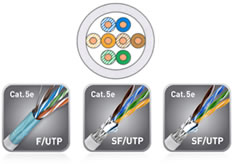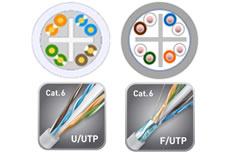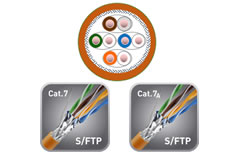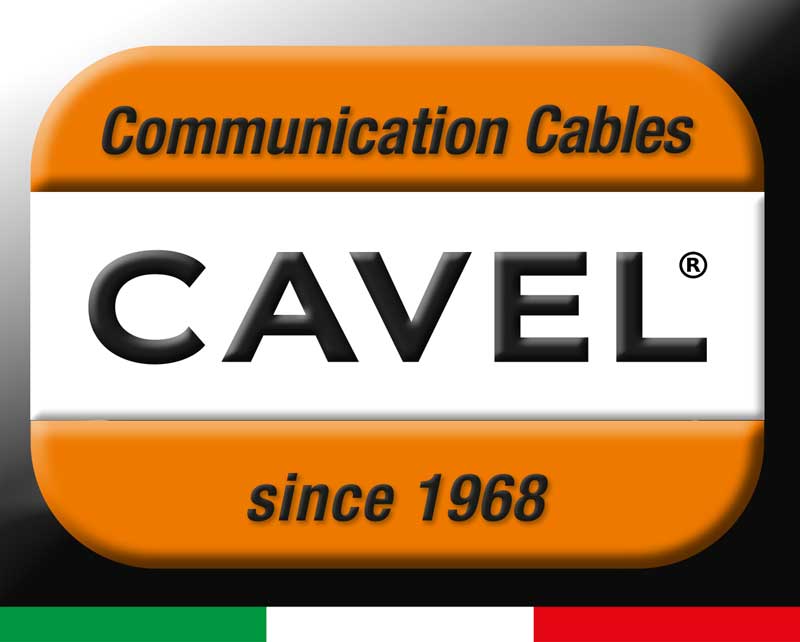LAN cables specially designed for greater flexibility (labeled with the acronym LANF) as well as special data transmission cables developed to specific client requirements are also available.
LAN cables (an acronym for Local Area Network, also called Ethernet cables) are the means by which data is transmitted within a so-called local area network, i.e., an integrated computer system consisting of shared computers and devices (such as those within a home, a business establishment, or a building complex).
DIFFERENCES AND CHARACTERISTICS OF LAN/ETHERNET CABLES
LAN cables are made up of four pairs of twisted pairs that are subsequently stranded together. The pairs have different twist pitches from each other in order to reduce interference between them, known as crosstalk (often abbreviated as NEXT, or Near End Cross Talk).
The main regulations governing the standard parameters to which LAN cables must adhere are as follows:
- ISO 11801 (International Standard Organisation)
- EN 50288 (European Standard)
- EN 50173 (European Standard)
- IEC 61156 (International Electrotechnical Commission)
- EIA-TIA 568 (Electronic Industries Association/Telecommunications Industry Association)
EN50288 CABLE STANDARD
In Europe, the standard regulating the standard parameters to which cables must adhere is EN50288.
According to these standards, LAN cables must have an impedance of 100 ± 5 Ohms at a frequency of 100 MHz. The maximum working frequency of the cable varies depending on the category.
LAN cable categories are divided into:
- Cat. 5e cables (enhanced): support frequencies up to 100 MHz and are suitable for applications up to 100BASE-TX (Fast Ethernet) at 100Mbit/sec over a maximum length of 100m (CHANNEL)
- Cat. 6 cables: support frequencies up to 250 MHz, suitable for network protocols up to 1000BASE-T / 1000BASE-TX (Gigabit Ethernet) at 1 Gbit/sec over a maximum length of 100m (CHANNEL)
- Cat. 6A cables (augmented): support frequencies up to 500 MHz, suitable for network protocols up to 10GBASE-T (10 Gigabit Ethernet) at 10 Gbit/sec over a maximum length of 100m (CHANNEL)
- Cat. 7 cables: support frequencies up to 600 MHz and are designed to allow transmission of network protocols up to 10GBASE-T (10 Gigabit Ethernet) at 10 Gbit/sec over a maximum length of 100m (CHANNEL)
- Cat. 7A1000 cables: support frequencies up to 1000 MHz and are designed to allow transmission of network protocols up to 10GBASE-T (10 Gigabit Ethernet) at 10 Gbit/sec over a maximum length of 100m (CHANNEL)
- Cat. 7A1200 cables: support frequencies up to 1200 MHz and are designed to allow transmission of network protocols up to 25GBASE-T (25 Gigabit Ethernet) at 25 Gbit/sec over a maximum length of 30m (CHANNEL)
- Cat. 7A1500 cables: support frequencies up to 1500 MHz and are designed to allow transmission of network protocols up to 40GBASE-T (40 Gigabit Ethernet) at 40 Gbit/sec over a maximum length of 30m (CHANNEL)
CABLES Cat. 5e

CABLES Cat. 6 e Cat. 6A

CABLES Cat. 7

CABLES Cat. 7A

Let us now take a look at the acronyms.
First, the letters next to the category number stand for:
e: enhanced.
A: augmented.
TYPES OF SHIELDING
The shielding of cables is necessary to protect the transmission of signals from external electromagnetic interference that could impair their quality. The different types of shielding used are presented below.
Shielding is generally made from:
- aluminum foils
- aluminum foils and tinned copper braid
which wrap the twisted pairs of cables individually or overall.
In fact, for high-frequency cable categories, aluminum foils that individually cover the pairs (Pairs in Metal Foil, PiMF) are also used in order to improve both the overall effectiveness of the shielding and the Next (Near End Cross Talk, or interference between pairs) values.
The acronyms used to denote shielding types initially included:
- UTP (Unshielded Twisted Pair): unshielded cable.
- FTP or STP (Foiled or Shielded Twisted Pair): shielded cable with aluminum foil (Foiled) or tinned copper braid (Shielded).
As technologies advanced and cable performance necessarily improved, further differentiations were introduced, as individual pairs of higher category cables (Category 6A and above) can also be shielded, mainly to reduce crosstalk (NEXT).
The following are acronyms used to denote cable shielding types, indicating the presence or absence of shielding overall in the cable and on individual pairs, providing information on the shielding configuration of LAN/Ethernet cables:
- U/UTP: unshielded cable, with no shielding either overall or for individual pairs.
- F/UTP: shielded cable, only overall with a foil wrapping around the 4 twisted pairs.
- U/FTP: shielded cable, only on the individual pairs.
- F/FTP: shielded cable, overall with foil, and with foils around the individual pairs.
- S/FTP: shielded cable, overall with braid, and with foils around the individual pairs.
- SF/UTP: double-shielded cable, overall with braid and foil, and individual unshielded pairs.
- SF/FTP: double-shielded cable, overall with braid and foil, and individual shielded pairs with foil.
HOW TO CHOOSE THE NETWORK CABLE - ETHERNET CABLE - LAN CABLE
| EIA TIA Category | Frequency | Standard | ISO Class 11801 (ISO/IEC) | For Ethernet installations up to no. meters of cable |
|---|---|---|---|---|
| Cat. 5e UTP | 1-100 MHz | EN 50288-3-1 | Class D |
100 m with Ethernet 10BASE-T, 100BASE-TX (Fast Ethernet), 1000BASE-T (Gigabit Ethernet), and 5GBASE-T This Cable can be called the standard LAN cable, using standard transmission frequencies |
| Cat. 5e FTP | 1-100 MHz | EN 50288-2-1 | Class D |
100 m with Ethernet 10BASE-T, 100BASE-TX (Fast Ethernet), 1000BASE-T (Gigabit Ethernet), and 5GBASE-T This Cable can be called the standard LAN cable, using standard transmission frequencies |
| Cat. 6 UTP | 1-250 MHz | EN 50288-6-1 | Class E |
100 m 10BASE-T, 100BASE-TX (Fast Ethernet), 1000BASE-T/1000BASE-TX, 2.5GBASE-T, 5GBASE-T 55 m with 10GBASE-T (10-Gigabit Ethernet) This type of cable is ideal for home use and features a better signal-to-noise ratio and zero connection errors |
| Cat. 6 FTP | 1-250 MHz | EN 50288-5-1 | Class E |
100 m 10BASE-T, 100BASE-TX (Fast Ethernet), 1000BASE-T/1000BASE-TX, 2.5GBASE-T, 5GBASE-T 55 m with 10GBASE-T (10-Gigabit Ethernet) This type of cable is ideal for home use and features a better signal-to-noise ratio and zero connection errors |
| Cat 6A UTP/FTP | 1-500 MHz | EN 50288-5-1 | Classe Ea |
100 m 10BASE-T, 100BASE-TX (Fast Ethernet), 1000BASE-T/1000BASE-TX, 2.5GBASE-T, 5GBASE-T 55 m with 10GBASE-T (10-Gigabit Ethernet) This type of cable is ideal for home use and features a better signal-to-noise ratio and zero connection errors |
| Cat. 7 (FTP) | 1-600MHz | EN 50288-4-1 | Class F | 100 m with 10GBASE-T (10 Gigabit Ethernet) |
| Cat. 7A (FTP) | 1-1000 MHz | EN 50288-9-1 | Class Fa |
50 m with 40 Gigabit Ethernet 15 m with 100 Gigabit Ethernet The cable is suitable for multiple applications, including transmission at 40 Gigabit Ethernet up to 50m, at 100 Gigabit Ethernet up to 15m, and CATV (band up to 862 MHz). Each pair offers up to 1,200 MHz of bandwidth. The best type of cable on the market today, ideal for business connections, they feature double shielding and support for the highest standards. |



